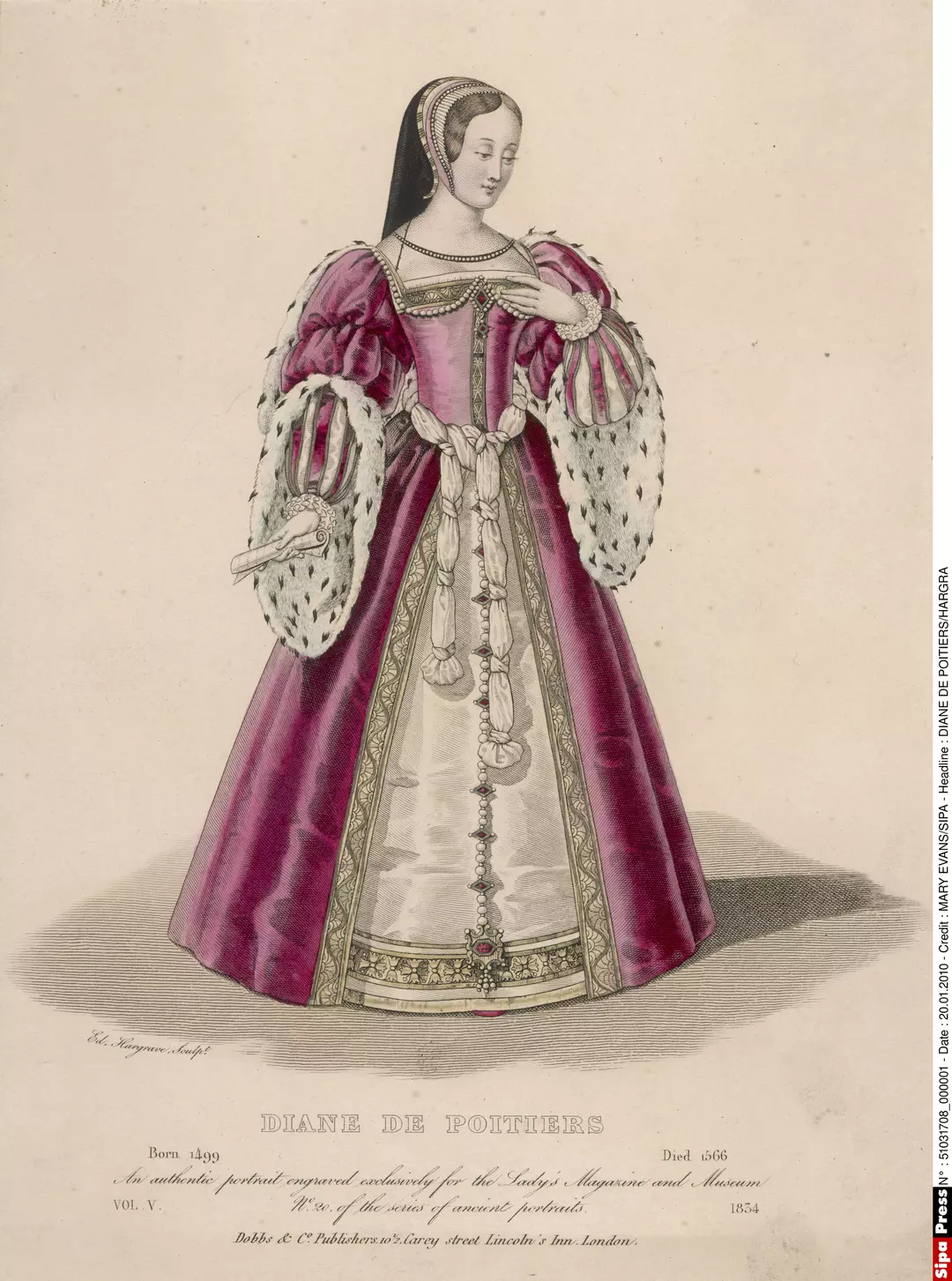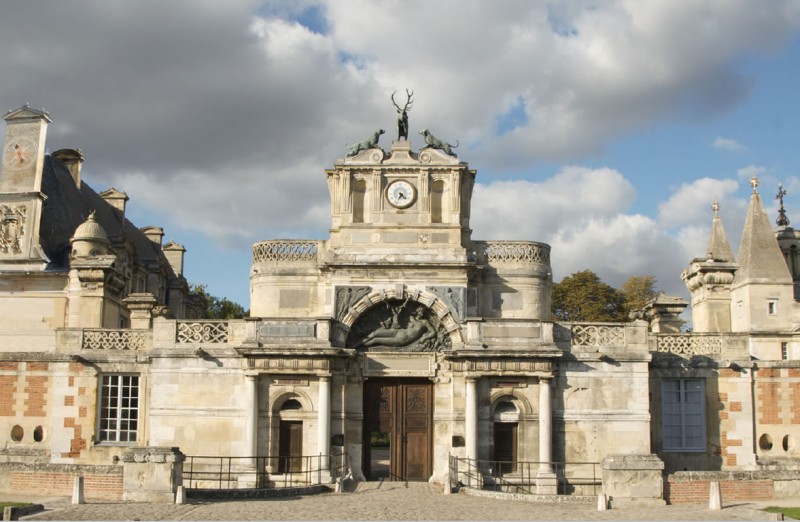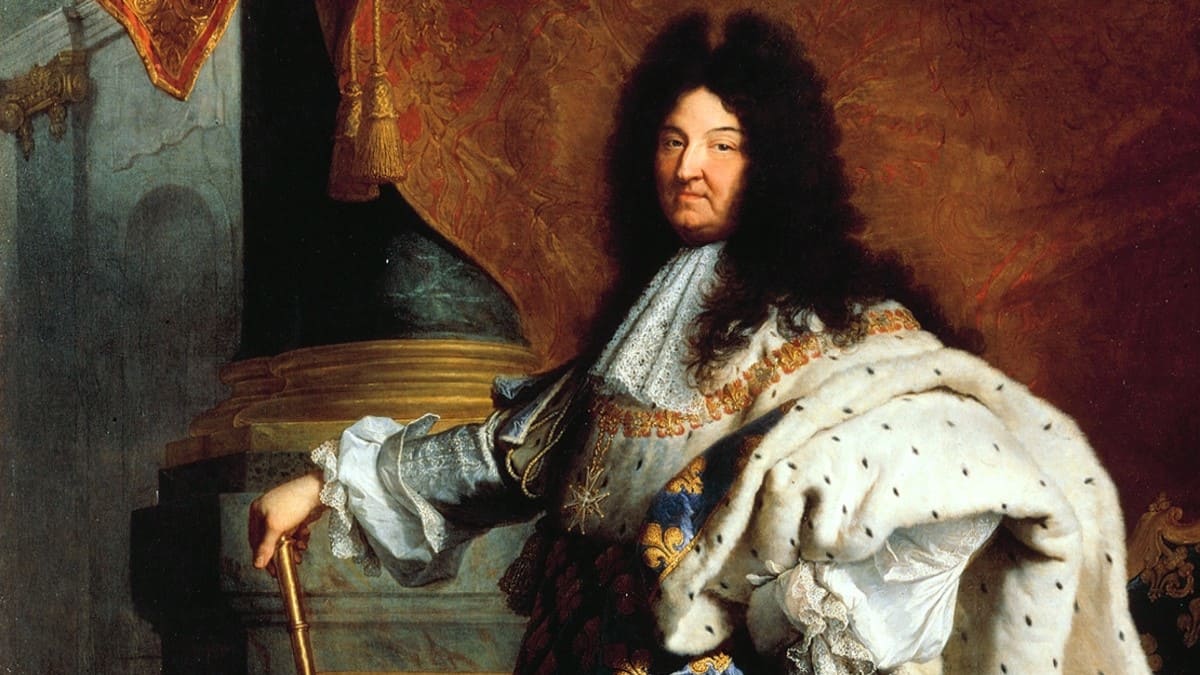King Henry II of France’s favorite, Diane de Poitiers (1499–1566), displaced Catherine de’ Medici as queen of France and built an exclusive court around herself. She was a strong, self-reliant lady who understood how to keep herself looking and feeling young. She stuck to her beliefs no matter what: “Be in respectable bearing, in a cool and confident manner, with a modest gaze and quiet tone, consistent and steadfast, always with a purpose, without bending, and with moderation in all things.” As a result of her efforts, Henry developed from an awkward youth into a troubadour, poet, horseman, and king. She went into seclusion in Anet after the shocking death of her husband, King, and passed away there on April 22, 1566.
Diane de Poitiers: A lady of the Renaissance

Diane, named after Diana, goddess of the hunt, was born on December 31, 1499, at the family castle in Dauphiné to Jean de Poitiers. Later in life, she inherited the Poitiers lion insignia, the Countess of Valentinois title, and the Château of Saint-Vallier from her grandfather. A wise lady said the newborn’s star would make her more powerful than any queen on the day of her birth.
As early as age six, she accompanied her father on hunting trips, learned to ride, and was given her very own falcon. She attended the court of Anne of France (or Anne de Beaujeu) and Louis XII after her mother’s death, where she was educated in Latin, Greek, theater, dance, philosophy, Plato’s reasoning, and, most importantly, disdain for intrigue, respect for status, a refined palate, and the skill of conversation. She served as Anne’s maid and afterwards as Claude’s upon her coronation as Queen Claude, wife of Francis I of France, in 1515.
As early as age six, she accompanied her father on hunting trips, learned to ride, and was given her very own falcon. She attended the court of Anne of France (or Anne de Beaujeu) and Louis XII after her mother’s death, where she was educated in Latin, Greek, theater, dance, philosophy, Plato’s reasoning, and, most importantly, disdain for intrigue, respect for status, a refined palate, and the skill of conversation. Attended King François I’s coronation in 1515 as a maid of honor for Queen Anne and later for the future Queen Claude, wife of Francis I of France.
She married Louis de Brézé, Grand Seneschal of Normandy and a wealthy, influential, and famous hunter, on March 29, 1515. Diane, with her tall stature, regal appearance, creamy white complexion, gray eyes, straight nose, tiny mouth, and big lips, was elevated to the third position in the kingdom.
Anet, a creepy and abandoned mansion, was where they called home. Louis de Brézé welcomed the king to his mansion and presented him with the city’s keys when he visited Rouen. In 1520, Francis I penned a portrait of Diana that was “beautiful to see, honest to haunt” because the Court had swiftly recognized that the Grand Seneschal of Normandy took her marriage extremely seriously and did not allow herself to be subjugated by the courtiers.
Her mother gave birth to little Francoise in 1518, and her father, Jehan, was arrested in September 1523, taken to Loches, stripped of all his property, sentenced to death, and then narrowly pardoned in February 1524 for life imprisonment for his role in the plot fomented by Charles V and Charles de Bourbon. Diane was said to be the King’s alleged mistress. Not only did the king deny it, but once his wife passed away in July 1524, he entrusted Diane with the guardianship of his children.
Diana comforted the eight-year-old dauphin Francis and the six-year-old Henry during the exchange of Francis I, a hostage of Emperor Charles V, for his children. Back in Rouen, the king took advantage of the Brézé family’s hospitality, and, impressed by Diane’s honesty, wit, and knowledge, he promoted her to lady-in-waiting to his mother, Louise of Savoy.
The meeting with the dauphin Henry
It was early in the summer of 1530 when the young king and queen finally came home. After being let down by his father, the young prince Henry sought comfort from Diane and Anne de Montmorency, the only two individuals who had ever shown him genuine devotion. After spending the fall with Diane and Louis de Brézé in Anet, the kids went back to Saint-Germain. Henry picked out his future wife, Diane, during a tournament held in honor of the new queen, Eleanor of Habsburg, sister of Charles V. Queen Eleanor, the king’s mistress Anne de Pisseleu, and Diane de Poitiers were all candidates for “the lovely among the beautiful” title. After realizing that she and the king’s mistress, Diane, were on equal footing, Anne de Pisseleu became obsessed with destroying her.
Louis de Brézé passed away in July of 1531. Since then, Diane, who had been living happily with her husband for the previous seventeen years, had worn exclusively black, accented with white, clothing. Her motto was “He who sets me on fire has the ability to extinguish me,” and the sign of a widow—a torch pointed downward—was placed on her coat of arms.
Diane moved to Anet to care for her when Louise de Savoie, the regent, passed away. Her daily routine consisted of a thorough cleansing with clean water, an ice water bath regardless of the temperature, a bowl of soup first thing in the morning, three hours of brisk horseback riding, and a light snack at 11 a.m. Diane rules over her territories, entertains guests, and goes to bed at 6 o’clock every night without ever applying makeup or exposing her white skin to the sun. She dresses in silk and wears a black velvet bodice with a deep neckline and long muslin sleeves that culminate in valuable stones at her waist.
Diane de Poitiers: Favorite of Henry II of France

Diane, a close aunt of Catherine de Medici, Henry’s future bride, was brought back to the court that fall of 1533 to serve as her guide and to teach her about French traditions and rites. Diane donned a black and white dress with white feathers for this royal wedding, which included a masked ball and countless dinners. Henry also sports a hat with white and black feathers. As a good husband should, he rushes back to his wife. Henry was dedicated to Diane de Poitiers from the time he was six years old until his death at the age of 42.
In spite of being loved by the king and invited on several hunts, Diane was the target of vicious attacks and accusations of witchcraft from the royal mistress. It’s clear that the mistress of the king and Diane have formed opposing factions. At this point, Henry takes the stand in open court to defend himself and reaffirm his love for Diane. During the “Affaire des Placards (English: Affair of the Placards),” an uprising led by the Reformed against the Catholics, Diane stands behind the king and Henry.
Henry, now the dauphin after Francis’s death, made his sentiments known to his close companions and spoke out for himself. Diane was smart and charming, and she wasn’t naive about using those qualities to get what she wanted. They almost certainly began a passionate affair near the end of 1536 or the beginning of 1537 at Anne de Montmorency’s favorite retreat, the castle of Ecouen. Diane wrote a short poem (of which the following is an excerpt) and sent it to Henry the morning after their first night together.
Here is really that Love, a beautiful morning, Came to offer me very nice flowers… Because, you see, such nice flowers Were boy, fresh, ready and young. …
Henry’s regular companionship with Diane had left him glowing with joy. Diane shares with him the joy of first love at a young age, and she teaches him all she had learned at Louis de Brézé’s side. Even if she didn’t actively pursue Henry’s affection, once she had it, she did all in her power to keep it, and she did so with the strength of her character and her wits until 1538, when she became the godmother of the little Diane de France (the daughter of Henry and Filippa Duci).
The future queen and the mistress “stick together”: one implores the king, the other takes care of the dauphin. Diane ushered Catherine into a private area, whispered softly, and instructed her on how to make love. On a few occasions, she had Henry spend the night at his wife’s. In January 1544, the long-awaited miracle occurred: Catherine gave birth to a healthy baby boy. Henry, overjoyed, presents Diane a quantity of money as a gesture of gratitude for her assistance with the dauphine.
The mistress had shown her worth once again. However, conspiracies were brewing at the court; the royal mistresses were at odds with one another, and Francis I of France (French: François I) had Diane exiled from the court while Henry was away at war. Upon returning from the war, he wasted little time in getting to Anet.
In February 1545, the king summoned Diana back to court, where she resumed her role with Henry and took responsibility for the upbringing of his two young children. After the death of Francis I of France in March 1547, she became closer to the Guises out of a sense that things were about to shift rapidly. For this position, Anne de Montmorency was chosen. In addition to being given the key to the vault and the authority to withdraw funds at whim, Henry also gave Diane the crown jewels from the royal treasury. In this scene, Henry offers Diane Anne de Pisseleu’s house. The second enjoys the recognition, but she doesn’t let it affect her composure.
Queen or royal mistress?
Diana was very invested in the workings of the government and the kingdom’s finances. She urged Henry to curb the lavishness of the court’s entertainment and pageantry by passing sumptuary laws, and she advocated for the elimination of certain positions within the court and the implementation of progressive social reforms (each district of Paris should constitute a social fund for the poor, and the hospitals should welcome the sick and the infirm). To show his gratitude and devotion, Henry presented her with Chenonceau, the crown jewel of the Loire Valley, which would be even more exquisite when the renovations were completed.
The needlework on Henry II’s robes during his coronation in July 1547 evoked Diana’s qualities (a quiver, bows, arrows, crescent moons, and a double D hanging on the H), yet the letter C of the queen was conspicuously absent. Diana took charge of the children’s upbringing when Catherine gave birth to her third child. Diane’s opinion is final. Everything from soldiers’ attire to the harnessing of horses during the September 1548 festivities in Lyon was black and white.
During these rites, Diane was elevated to the rank of duchess of Valentinois, the highest honor that can be bestowed upon a person who was not born a princess. The Parisian display in May 1549 is considerably worse than the one before it. All the letters were “knotted H and D,” and the color palette is limited to black and white. Only Diane was trusted by Henry; she signed official correspondence as “HenriDiane” and sat on the Privy Council. Despite this, she was still the target of animosity and had to dispel rumors that she was responsible for the persecution of heretics. Henry II expressed his support for her.
Anet: A castle for the king and his favorite

They stayed at Anet for weeks, during which time they went on long horseback rides and hunts in the mornings and had lavish feasts in the evenings. Henry had portraits made of his favorites; the tradition of portraits in the bath dates from this period. Henry’s recovery from his captivity in Spain, the joyous visits of the royal children, and the king’s fondness for quiet library sessions all attest to the fact that Anet was a veritable paradise (all the books were bound in red morocco decorated with the figure of the king and his lady, one of the most prestigious collections of the Renaissance).
Henry made Anet his capital, where he issued orders, wrote letters, and had audience sessions.
The people in Diane’s group thought highly of her. Upon their arrival in France, she was entrusted with the care of the little Mary Stuart. Lady Fleming, her governess and Henry II’s mistress, traveled with the princess in her suitcase. No matter how hard he tries to cover up his affair, the royal mistress had her loyal companions to rely on. A return to Scotland was ordered for Lady Fleming.
When Diane found out that Anne de Montmorency was complicit in the scandal, he became enraged. Now, he plans to have Diane deposed. Their offspring would bring peace between the Constable and the King’s mistress.
Despite their numerous disagreements, the queen and the royal mistress were forced to coexist throughout the war years of 1552–1557. One day, Diane dropped by Catherine’s place, where the latter was sitting and reading. After her curiosity was piqued, Diane inquired as to what she was reading. “I study the chronicles of this country, and I learn that, from time to time, at any period, the prostitutes have handled the affairs of kings.”
An slur that went viral all throughout the kingdom. Diane retaliated by having Montmorency say that, of all the king’s offspring, only Diane of France resembled the monarch, a remark that became widely circulated throughout the country’s courts.
The last years of Diane
Rejoicing, including tournaments and jousting, resumed in 1558 and July 1559, in conjunction with marriages, after the ceasefire with Spain. It was a well-known tragedy when the king was fatally injured in a joust. Diane ran to be by his side, but the queen stopped her. Diane de Poitiers had never before felt so helpless; she was terrified of witnessing the death of France’s monarch and even more so of bearing the brunt of the Queen’s vengeance. They had no power without Henry.
After getting some news, Diane de Poitiers goes home. Even though she had not been invited, she was glad to see the burial from a window. There was no white and black clothing on the effigy of the monarch, no crescent moon, and no HD on the harness of the king’s horse. In April 1560, a document of transfer was completed between her and Queen Catherine de Medici, who had promised her the fortress of Chaumont sur Loire in exchange for Chenonceau.
When Diane visited Catherine’s former estate in Chaumont sur Loire, she was shocked to find numerous artifacts associated with necromancy and alchemy left behind by the queen, including an altar adorned with Greek, Egyptian, and Hebrew characters, powder flasks and jars of brine containing animal limbs, as well as strange works, parchments, and animal remains. She left Chaumont to her daughter Françoise after burning everything in the house.
She moved on to Anet, where she could continue to dwell in Henry’s shadow. Despite a horse accident that shattered her leg, she remained in great shape and looked stunning as she entered her 60s. She had just turned 64.
The death of Diane de Poitiers
Diane de Poitiers, who lived to be 66 years old, passed away at her castle of Anet on April 26, 1566, following a terrible but short illness (perhaps food poisoning). Françoise de Brezé and Louise de Brezé inherited a large portion of their mother’s wealth, and she also left money to many religious institutions. Several hundred impoverished peasants in white followed the casket as they sang, “Pray to God for Diane de Poitiers,” during her burial.
She was laid to rest in the mausoleum she had constructed on the grounds of the castle. In 1795, French rebels uncovered her grave and snipped her hair for souvenir locks. Years later, the castle was auctioned brick by brick.





